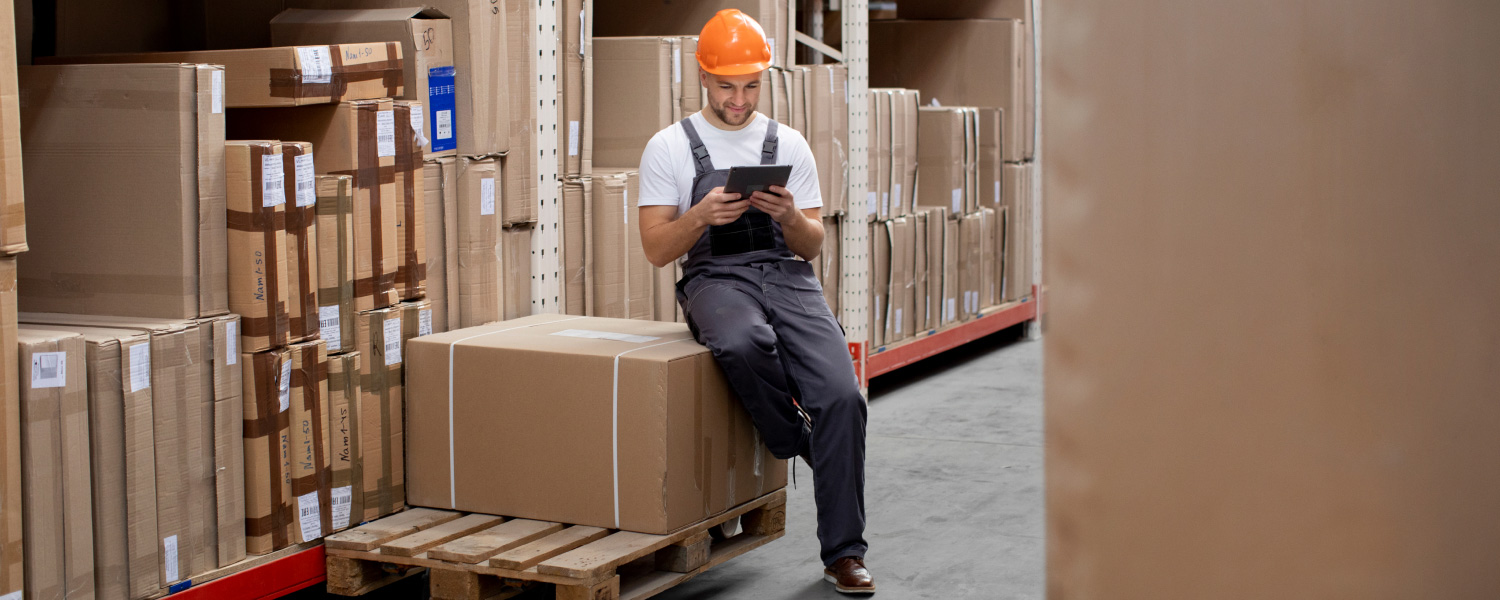Imagine managing a warehouse could be as easy as browsing your favorite website.
Warehouse automation makes this possible, replacing outdated warehousing methods with a streamlined, digital approach.
This innovation allows companies to quickly locate and ship products, track inventory levels with precision, and make smarter business decisions.
77% of organizations are actively pursuing warehouse automation and are developing strategies to enhance performance through data-driven methods.
In this post, we’ll talk about the issues faced by traditional warehouses, break down the concept of warehouse automation, and provide some handy best practices for getting it right.
Let’s get started!
What is an Automated Warehouse?
An automated warehouse essentially digitizes your inventory, whether stored in one central location or spread across multiple warehouses nationwide.
An automated warehouse system provides a comprehensive view of your warehouse operations, but its benefits go much deeper than just visibility.
The real strength of automated warehousing lies in its capability to efficiently manage and synchronize your stock across different channels and locations.
Imagine an automated system that collects and updates real-time information on everything from the inventory of finished products to raw materials.
This is what warehouse automation brings for you!
It’s important to clarify that automation doesn’t necessarily involve robots or mechanical systems.
Often, automated warehouses mean deploying software tools and services that help eliminate manual tasks, saving time and reducing the physical demand on warehouse personnel.
Why are Traditional Warehouses Becoming Obsolete?
Traditional warehouses are increasingly viewed as outdated due to a variety of inherent challenges that compromise their efficiency and accuracy.
Here are three key challenges that explain why traditional warehouses are losing their charm:
1. Inventory Inaccuracy
Traditional warehouses typically struggle with maintaining accurate inventory counts.
It can be due to manual data entry errors, misplaced items, or insufficient tracking systems.
Inventory inaccuracies lead to issues like overstocking or stockouts, which can disrupt operations and lead to lost sales.
2. Inefficient Space Utilization
Without advanced optimization algorithms, traditional warehouse management may not effectively use available space.
This can result in cluttered storage areas, longer retrieval times, and increased costs due to underutilized space.
Efficiently organizing and utilizing space is crucial for operational effectiveness and cost management.
3. Labor-Intensive Processes
Many traditional warehouse operations rely heavily on manual processes for tasks such as picking, packing, and sorting.
This reliance on human labor can lead to higher operational costs, slower processing times, and increased likelihood of human error.
It can also be challenging to scale operations quickly in response to increasing demand without significant additional labor costs.
Automated Warehouse Systems: Advanced Technologies in Modern Warehousing
Modern warehouses use automated warehouse systems designed to enhance efficiency and accuracy across various operations.
Here’s how these technologies are applied in automated warehouse systems:
1. Goods-to-Person Robotics
Goods-to-person robotics systems use robots to fetch and deliver items directly to operators, minimizing walking distances and boosting the speed of order fulfillment.
2. Automated Sorting Systems
Using advanced conveyor belts and sorting mechanisms, these systems automatically classify, and direct items based on set parameters, streamlining the distribution process.
3. Smart Inventory Management
Employing sensors coupled with Warehouse Management Systems (WMS), this technology oversees inventory levels, tracks movements, and automates the replenishment of stock, ensuring optimal inventory control.
4. Picking Robots
Picking robots assist staff by providing guidance on item handling, which enhances picking accuracy and reduces the likelihood of mistakes.
Best Practices for Implementing Automation Warehouse System

An automated warehouse management system is crucial for modern businesses seeking to optimize their logistics operations.
In this section, we’ll discuss key best practices for effectively using these automation warehouse systems, providing a roadmap for successful implementation.
1. Establish Clear Procedures for Your Automated Systems
It’s a common misunderstanding that technology alone will handle all tasks and decisions.
However, even the most sophisticated automated systems require clear, well-defined processes to truly maximize their return on investment.
Here’s how you can set clear processes:
- Document Procedures: Clearly outline and document all processes related to the automated system, including step-by-step instructions for handling exceptions and changes.
- Training and Support: Regularly train team members on these procedures and provide ongoing support to ensure everyone understands their roles and responsibilities.
- Continuous Review: Periodically review and update processes to adapt to new business rules and technological advancements, ensuring the system remains efficient and effective.
Business rules change and exceptions arise, so team members must know the specific actions and protocols to follow to effectively manage these situations as they occur.
2. Optimize your Warehouse Layout
Automating your warehouse can streamline workflow but a flawed warehouse layout can prevent you from fully benefiting from your automated system.
Systematically assess your space and understand your warehouse’s throughput to identify any processing gaps.
According to some estimates, 59% of warehouses use up to 90% of their available space.
Here are some of the common layouts to properly utilize your warehouse space:
- U-Shaped Layout: This layout allows for efficient movement of goods and minimizes travel time by organizing receiving, storage, and shipping areas in a U-shape.
- L-Shaped Layout: It optimizes space and workflow by placing receiving and shipping areas on adjacent sides of the warehouse, allowing for smooth product flow.
- Straight-Line Layout: This layout streamlines processes by arranging receiving, storage, and shipping areas in a straight line, reducing handling time and improving efficiency.
Once you have this understanding, you can make the necessary adjustments to create an optimal layout for your business needs.
We suggest exploring various layout configurations when assessing your warehouse layout.
3. Evaluate Multiple Warehouse Automation Companies
When considering warehouse automation, it’s crucial to evaluate warehouse automation companies to find the best fit for your specific needs.
Keep these three points in mind during evaluation for long-term success:
- Compatibility: Ensure the automation solutions can integrate seamlessly with your existing systems.
- Customization: Evaluate the level of customization each company offers to meet your specific needs.
- Support: Consider the quality and availability of their support and maintenance services to ensure long-term efficiency.
Schedule a demo with Teamship’s warehouse automation software to see how it can help automate your warehouse processes for maximum efficiency and simplicity.
4. Ensure Comprehensive Traceability in Your System
Are you confident in your supply chain’s transparency from start to finish?
One of the best practices for implementing warehouse automation is to ensure your system has complete traceability.
With growing compliance demands, it’s more important than ever to know exactly what components are used and where your products are.
If you don’t have full visibility into every step of your supply chain, you can’t guarantee the safety of your end consumers.
The demand for thorough traceability, from raw materials through production, will continue to rise.
Save yourself time and reduce frustration by making traceability simpler and more manageable now.
5. Train your Warehouse Employees
Notably, companies that have comprehensive employee training programs see 218% higher income per employee compared to those without formalized training.
A critical best practice for implementing warehouse automation is to ensure that your employees are well trained.
Automation technology can transform warehouse operations, but its success largely depends on how effectively your staff can interact with and manage these new systems.
- Comprehensive Training Programs: Develop detailed training programs covering all aspects of the automated systems.
- Ongoing Education and Support: Offer continuous education and support to keep the team updated on new features and best practices.
- Encourage Employee Feedback: Create an environment where employees can provide feedback to improve the automation process.
By investing in thorough and continuous training for your warehouse employees, you pave the way for a smoother transition to automation warehouse systems.
From Chaos to Efficiency: Garland Canada’s Journey with Teamship Automation
Garland Canada turned their complex, error-prone warehouse operations into a seamless system with Teamship automation. Find out how!
Lost in Logistics: Garland Canada’s Struggle with Multiple WMS
Garland Canada was stuck in a logistical maze.
Managing five different warehouse management systems (WMS) with various 3PL warehousing partners was a daily struggle.
Logistics and shipping coordinators had to log into each system separately just to keep stockouts at bay.
Reporting was even worse: importing data into Excel, creating a master sheet manually, matching headers, and ensuring uniform formatting.
It was a painstaking and time-consuming process that left everyone frustrated.
Seamless Integration and Simplified Operations
Everything changed when Garland Canada partnered with Teamship for warehouse automation.
- Teamship’s user-friendly warehouse management system integrated all their previous WMS into a single, easy-to-use login.
- Suddenly, they could manage inventory, orders, and shipments all in one place.
- Real-time reports provided a comprehensive view across all their warehousing partners, making what was once a complex and error-prone process incredibly simple.
The transformation was remarkable; Garland Canada’s warehouse logistics became smooth and efficient.
Experience Effortless Warehouse Automation with Teamship
Garland Canada’s experience shows how Teamship can automate your warehouse operations effortlessly.
By integrating Teamship, you can simplify operations, improve precision, and increase productivity.
Reach out to us today to see Teamship in action.
Final Thoughts
Warehouse automation offers numerous benefits, but its success relies on proper implementation.
According to a report by Peerless Research Group, 60% of warehouses say that the implementation of automation is their biggest challenge.
Follow these five best practices for a smooth transition to automation and unlock your warehouse’s complete potential.
Frequently Asked Questions
1. What are the three levels of warehouse automation?
- Manual Warehouse: In a manual or conventional warehouse, all tasks are performed by human workers using tools such as forklifts and other lifting or transport equipment. This level relies heavily on human effort and manual processes.
- Partially Automated Warehouse: This level incorporates some automation to assist with warehouse operations. For example, automated conveyor systems or robotic picking systems might be used alongside human workers to improve efficiency and reduce manual labor.
- Fully Automated Warehouse: In a fully automated warehouse, most or all operations are performed by automated systems and robotics. This includes automated storage and retrieval systems (AS/RS), robotic sorting, and automated guided vehicles (AGVs), which handle tasks with minimal human intervention.
2. Can automated warehouses increase overall efficiency?
Yes, implementing automation in warehouses can greatly enhance efficiency.
By automating repetitive and time-consuming tasks such as data entry, order picking, and inventory management, warehouse managers can save time and reduce errors.
3. What are the three main types of automation?
The three main types of automation in production are:
- Fixed Automation: This type is used for high-volume production and involves dedicated equipment for specific tasks, making it highly efficient but inflexible to changes.
- Programmable Automation: Suitable for batch production, this type of automation allows for reprogramming to accommodate different tasks or products, providing more flexibility than fixed automation.
- Flexible Automation: The most versatile type, flexible automation can adapt quickly to various tasks or product changes without significant reconfiguration, making it ideal for environments with varied production requirements.

